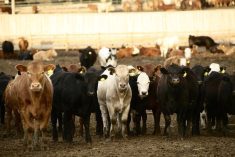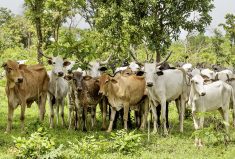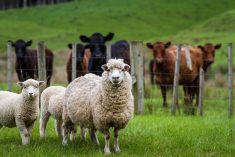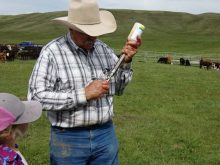PED in the pork industry should be a recent and staunch reminder to all livestock sectors that preventing animal diseases is the cornerstone to crisis prevention. Where and how porcine epidemic diarrhea virus emerged as a killer of nearly four million young pigs in the U.S. remains a mystery. We know it’s highly contagious and easily transmitted between hog operations. It should not be a surprise to anyone that PED jumped the border into Canada.
Bad habits perpetuated by trade merged with husbandry practices that forever lag with what we know scientifically are important precursors to animal health crises. New evidence indicates PED may be linked to incorporating highly digestible protein from porcine serum collected at slaughter into early weaning rations. The livestock industry’s search for cheaper ways to produce food enhances the tendency to find ways of recycling animal products in feed — déjà vu 2003 and the decade-long struggle with BSE.
Read Also

What to know before you go to Agribition 2025
If you’re attending Agribition 2025, this is the place to find out about tickets, dates and what’s happening this year.
- More from the Canadian Cattlemen: On-farm biosecurity: Keep it practical
Still the most important way to avoid a crisis with any disease is to make sure not to bring it home. For example, even in the face of what we knew about PED, virus-laden boots carelessly transported back from the U.S. found their way into Saskatchewan, without consequence we think. Most cases of bovine virus diarrhea (BVD) in commercial herds began with the purchase of permanently infected animals (PI) from auction markets or herds of unknown disease status. Many cases of scour and respiratory disease outbreaks start with the purchase of orphan calves as replacements for those lost during calving. Johne’s disease commonly and unknowingly walks onto farms in latent shedders purchased as bull or heifer replacements. The introduction of many diseases is silent and insidious. The unfortunate fact is most people pay very good money for disease. That bull purchased just before the breeding season without a thorough health check, that group of young cows with calves that seemed like such a bargain during calving season, or that calf you bought to put on a cow that lost hers can all be disease carriers that devastate herds.
Unfortunately, much of our livestock biosecurity mentality has been formed around prevention and reaction to threats of catastrophic foreign animal disease, especially foot-and-mouth disease (FMD). Although FMD poses a very real and dangerous threat to the health of the North American cattle and swine industry, applying biosecurity practices to indigenous diseases achieves the greatest return on investment, and establishes a core of practices that prevent those that ravage nations.
Clint Peck, director, Beef Quality Assurance, Montana State University and contributing editor to Beef magazine in a 2008 article made the following statement: “We know disease transmission can’t be completely avoided, but basic logic and management can be employed to effectively prevent unwanted biological invasion.”
In the same article, Peck mentions the landmark report, Animal Health at the Crossroads published in July 2005 by the National Academy of Sciences (NAS), and the contention made by its authors, which included Canadians, that while safeguarding animal health was of paramount importance to the North American economy, public health and the food supply, the animal health framework has been slow to validate and implement new scientific tools and technologies that could significantly enhance animal disease prevention.
By default, the onus falls on the production sector and its ability to work with the veterinary profession to develop community-based approaches to livestock biosecurity. This means changing animal health paradigms and ranch management practices.
Disease prevention in effect becomes the function of doing simple things right every day. Good disease control increases time spent on management, planning and record-keeping. Disease prevention doesn’t require that you operate a livestock operation in a totally enclosed and controlled environment. It’s systematic.
A successful biosecurity plan covers three main areas — isolation, traffic control and sanitation. Over 60 per cent of producers add new cattle to herds without isolating replacements. Breeding bulls are often bought and purchased with no knowledge of the animal health status of herds from which they originate.
Truisms about disease prevention to prevent a crisis:
- Partner up. Personal connections with a herd health veterinarian are necessary to plan disease prevention properly and tailor disease prevention to an operation’s needs.
- “Know thy neighbour” and the programs and background of purchased animals. Hundreds of hours are spent studying EPDs, thousands spent buying bulls and replacement females, but almost no time is spent reviewing ranch-of-origin’s health programs.
- Foundations of disease control in herds are: isolation, traffic control and sanitation.
- Understand how disease is introduced and spread. Carrier animals can appear normal, so quarantine and test before purchase. Consider water sources, manure, vehicles, wildlife, feedstuffs, and non-livestock such as dogs, birds, insects and humans.
- Biosecurity is both cost effective and the least costly control program for preventing disease.
- Know thy own herd.
- Understand disease susceptibility. Young animals are nearly always more susceptible. Don’t introduce animals during calving season.
- Disease doesn’t respect fences.
- To a large extent health risks can be mitigated by anticipating occurrence, managing risk factors and assuring everyone on the team understands what is being done and why.
- Managing risk: Prioritize disease and diseases control measures. Concentrate on the ones that have the greatest impact; determine what practices need to be changed to prevent introduction/transmission of disease. Think systems and population medicine. Make sure the process is clearly understood by everyone involved and maintain records of health and productivity.
- Health management is only as effective as the weakest part.
Disease doesn’t generally sneak into a herd like a skilful burglar; it walks boldly onto the farm or ranch through the front pasture gate.
Dr. Ron Clarke prepares this column on behalf of the Western Canadian Association of Bovine Practitioners. Suggestions for future articles can be sent to Canadian Cattlemen ([email protected]) or WCABP ([email protected]).
















